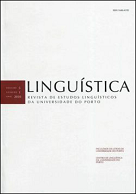The Lateral Segment /l/ in Internal Rhyme. Sonority and Nuclearization in European Portuguese
Abstract
In European Portuguese, the common articulation of the lateral segment /l/ in implosive position has a secondary (vocalic) articulation on the velar region: malta - ma[ɫ]ta. Other systems, namely Brazilian Portuguese, show vocalized productions: malta - ma[w]ta. These productions, that appear in many other linguistic varieties, may be interpreted as a step of a nucleation process, based on dyachronic changes as well as on phonetic and phonological data of many languages. The present paper presents the results of several phonetic analysis of standard European Portuguese informants. The data show strong relation between the implosive lateral segment and the precedent vowel, whose pure vocalic part reduces up to 33% of the sequence. These realizations do not only modify the articulation of /l/, but also the sonority of the segment, that increases as the segment adquires vocalic features. Based on the phonetic analysis, this work proposes that the velarization of /l/ is an intermediate step of a more general nucleation process, that corresponds to the increase in sonority of the segments at the right of the nucleus.
References
Andrade, A. 1999. On /l/ velarization in European Portuguese. In: J. Ohala; Y. Hasegawa; M. Ohala; D. Granville; A. Bailey (eds.). Proceedings of the 14th International Congress of Phonetic Sciences, San Francisco, 543–546.
Archangeli, D. 1988. Aspects of Underspecification Theory. Phonology Yearbook. 5: 183-207.
Artstein, R. 1998. The incompatibility of underspecification and markedness in Optimality Theory. In: R. Artstein; M. Holler (eds.). RuLing Papers 1: Working Papers from Rutgers University. Rutgers University Department of Linguistics, New Brunswick, 7-13.
Bladon, R. A. W.; Al-Bamerni, A. 1976. Coarticulatory resistance in English /l/. Journal of Phonetics. 4: 137–150.
Clark, J.; Yallop, C. 1996. An Introduction to phonetics and phonology. Blackwell, Oxford & Cambridge, segunda edição.
Colman, F. 1983. ‘Vocalisation’ as nucleation. Studia Linguistica. 37: 30-48.
Freitas, Mª. J. 1998. Estatutos das consoantes que fecham sílabas no português europeu: evidência dos dados da aquisição. In: Actas do XIV Encontro Nacional da Associação Portuguesa de Linguística. 1, APL, Aveiro, 541-555.
Garcia, M. 2008. Português Europeu e Galego. Estudo Fonético e Fonológico das Consoantes em Rima Medial. Tese de Mestrado, Universidade de Lisboa.
Girelli, C. A. 1988. Brazilian Portuguese Syllable Structure. Tese de Doutoramento, University of Connecticut.
Hahn, L. H.; Quednau, L. R. 2007. A lateral pós-vocálica no português de Londrina: análise variacionista e estrutura silábica. Letras de Hoje. 42(3): 100-113.
Itô, J.; Mester, A. 1994. Reflections on CodaCond and Alignment. In: Phonology at Santa Cruz. 3: 27-46.
Mateus, M. H. M.; Andrade, E. d’ 2000. The Phonology of Portuguese. Oxford: Oxford University Press.
Morales-Front, A.; Holt, E. 1997. On the interplay of morphology, prosody, and faithfulness in Portuguese pluralization. In: F. Martínez-Gil; A. Morales-Front (eds.). Issues in the Phonology and Morphology of the Major Iberian Languages. Washington D. C, Georgetown University Press, 393-437.
McCarthy, J. J.; Prince, A. 1995. Faithfulness and reduplicative identity, In: J. Beckman; L. Walsh Dickey; S. Urbanczyk (eds.). Papers in Optimality Theory. 18 University of Massachusetts Occasional Papers. Graduate Linguistic Student Association, Amherst, Massachusetts, 249-384.
Praat: doing phonetics by computer: http://www.fon.hum.uva.nl/praat/
Piñeros, C.-E. 2007. The phonology of implosive nasals in five Spanish dialects: An optimality account. In: F. Martínel-Gil; S. Colina (eds.). Optimality-Theoretic Stu- dies in Spanish Phonology. Amsterdam: John Benjamins.
Prince, A.; Smolensky, P. 1993. Optimality theory: constraint interaction in generative grammar. Cambridge. MIT.
Recansens, D.; Espinosa, A. 2005. Articulatory, positional and coarticulatory characteristics for clear /l/ and dark /l/: evidence from two Catalan dialects. Journal of the International Phonetic Association. 1(35): 1-25.
Sproat, R.; Fujimura, O. 1993. Allophonic variation in English /l/ and its implications for phonetic implementation. Journal of Phonetics. 21: 291-311.
Downloads
Published
Issue
Section
License
Copyright (c) 2017 Linguística Revista de Estudos Linguísticos da Universidade do Porto

This work is licensed under a Creative Commons Attribution-NonCommercial 4.0 International License.



